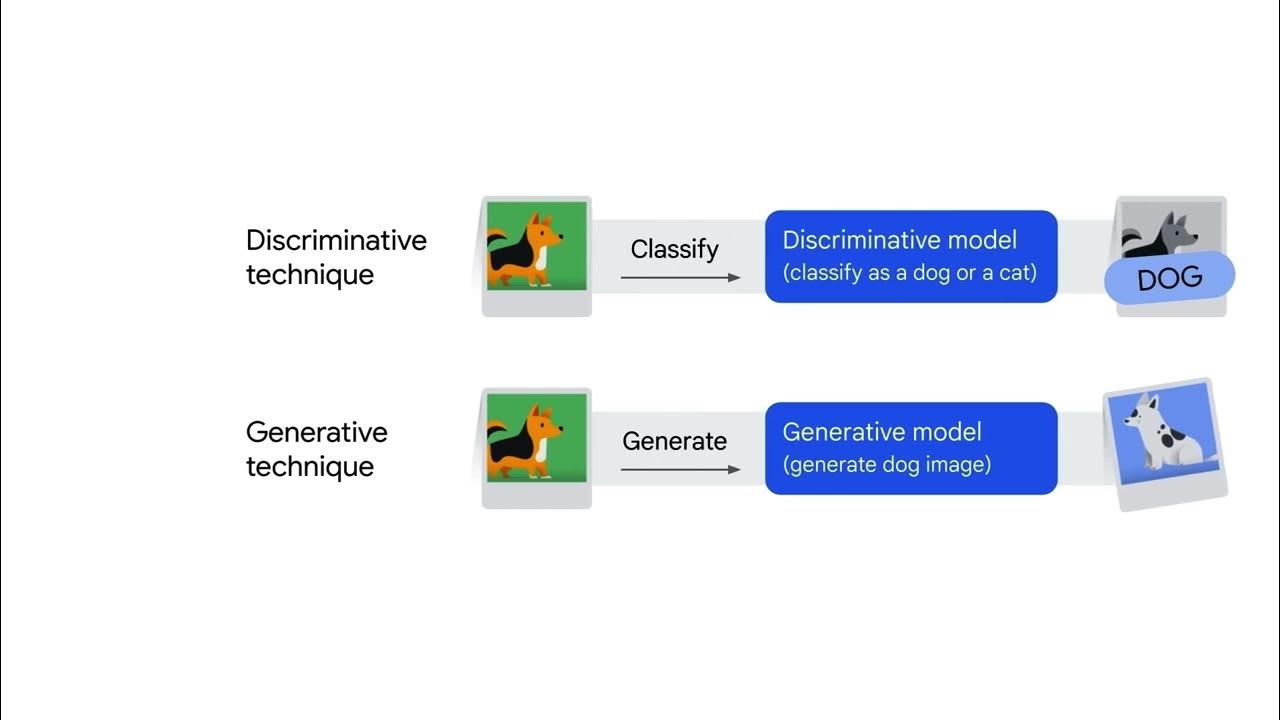Introduction to Generative AI
Summary
TLDRThis video script explores generative AI, covering key concepts like machine learning, deep learning, and natural language processing. It introduces Transformer models and their impact on NLP, emphasizing the role of large language models (LLMs) in gen AI applications. The script also discusses prompt engineering for effective model interaction and the use of APIs for model access. It outlines steps for building AI applications, such as chatbots, and techniques like retrieval-augmented generation (RAG) and fine-tuning for customizing AI models to specific needs.
Takeaways
- 🌟 **Generative AI (Gen AI)** is a rapidly evolving field with new models and applications emerging regularly, necessitating staying current with the latest developments.
- 💡 **AI Terminology**: AI involves creating computer systems capable of tasks requiring human intelligence, including subfields like machine learning, NLP, and computer vision.
- 📚 **Machine Learning**: A subset of AI focusing on enabling computers to learn and improve from data, typically through pattern recognition and predictions.
- 🧠 **Deep Learning**: Utilizes artificial neural networks to process and generate sequential data, with Transformer models being a significant advancement in this field.
- 💬 **Natural Language Processing (NLP)**: An AI subfield aimed at enabling computers to understand, interpret, and generate human language, with tasks like text classification and machine translation.
- 📈 **Large Language Models (LLMs)**: AI models trained on vast text data to generate humanlike text, central to many Gen AI applications.
- 🔍 **Prompt Engineering**: The practice of designing effective prompts to guide Gen AI models to produce desired outputs, requiring an understanding of model capabilities and limitations.
- 🔗 **Model APIs**: Generative AI models are often accessed via REST APIs, requiring API keys and adherence to best practices for secure and efficient use.
- 🛠️ **Building AI Applications**: Gen AI can be utilized across various domains to create applications like chatbots for personalized recommendations, involving choosing an LLM provider, setting up a development environment, and integrating the model.
- 🔧 **Customizing AI Models**: Techniques like Retrieval-Augmented Generation (RAG) and fine-tuning allow for tailoring AI models to specific needs, enhancing performance in domain-specific tasks.
Q & A
What is Generative AI (Gen AI) and its significance?
-Generative AI, or Gen AI, refers to AI systems capable of creating new content such as text, images, and music. It's a subset of deep learning that uses deep learning models to learn patterns and representations from existing data to generate novel outputs resembling the training data.
How does machine learning differ from AI, and what is its role?
-Machine learning is a subset of AI that enables computers to learn and improve from data without explicit programming. It involves training models on data to recognize patterns, make predictions, and take actions.
What is the importance of Natural Language Processing (NLP) in the context of AI?
-NLP is a subfield of AI that enables computers to understand, interpret, and generate human language. It includes tasks such as text classification, sentiment analysis, machine translation, and text generation, and is crucial for developing systems that can interact naturally with humans.
What are Transformer models, and how have they impacted NLP?
-Transformer models are a type of deep learning model architecture introduced in the 2017 paper 'Attention Is All You Need.' They rely on self-attention mechanisms to process and generate sequential data like text and have become foundational for many NLP models, revolutionizing the field.
What is the role of large language models (LLMs) in Gen AI applications?
-LLMs are AI models trained on vast amounts of text data to understand and generate humanlike text. They can perform a wide range of language tasks and are central to many Gen AI applications, providing the ability to answer questions, write essays, and even code.
What is prompt engineering, and why is it important for Gen AI models?
-Prompt engineering is the practice of designing effective prompts to guide the output of Gen AI models. It involves understanding the model's capabilities, limitations, and biases. Effective prompts provide clear instructions, relevant examples, and context to achieve desired outputs from the model.
How can one access and use generative AI models through APIs?
-Generative AI models are typically accessible through REST APIs. To use them, one needs to obtain API access from platforms like OpenAI or Hugging Face, secure an API key, and authenticate requests. It's important to follow best practices for reliability and efficiency, including managing rate limits and securing API keys.
What are some use cases for Gen AI-powered applications across different domains?
-Gen AI-powered applications have various use cases, including marketing, customer support, business and finance, and education. For example, building a chatbot that uses an LLM to provide personalized book recommendations based on user preferences.
What is retrieval-augmented generation (RAG), and how does it enhance AI models?
-RAG allows AI models to access external information sources in real-time, providing the most up-to-date and relevant information to answer specific questions. It combines information retrieval with language generation, leading to more accurate and relevant responses, especially for complex questions requiring synthesized information.
How does fine-tuning customize AI models for specific needs?
-Fine-tuning adapts a pre-trained AI model to specific needs by improving its performance on domain-specific tasks. It starts with a foundational model trained on general data and tailors it to a specific domain or task data set. The model's performance is tested and refined as needed, resulting in a model with expertise in the domain.
Outlines

Этот раздел доступен только подписчикам платных тарифов. Пожалуйста, перейдите на платный тариф для доступа.
Перейти на платный тарифMindmap

Этот раздел доступен только подписчикам платных тарифов. Пожалуйста, перейдите на платный тариф для доступа.
Перейти на платный тарифKeywords

Этот раздел доступен только подписчикам платных тарифов. Пожалуйста, перейдите на платный тариф для доступа.
Перейти на платный тарифHighlights

Этот раздел доступен только подписчикам платных тарифов. Пожалуйста, перейдите на платный тариф для доступа.
Перейти на платный тарифTranscripts

Этот раздел доступен только подписчикам платных тарифов. Пожалуйста, перейдите на платный тариф для доступа.
Перейти на платный тарифПосмотреть больше похожих видео

How I’d Learn Machine Learning in 2024 (If I Were Starting Over)

Roadmap to Learn Generative AI(LLM's) In 2024-Krish Naik Hindi #generativeai

Best FREE AI Courses for Beginners in 13 Minutes 🔥| Become an AI Engineer in 2024

How to learn AI in 2024? Beginner Friendly Roadmap

Machine Learning vs. Deep Learning vs. Foundation Models

Introduction to Generative AI
5.0 / 5 (0 votes)
